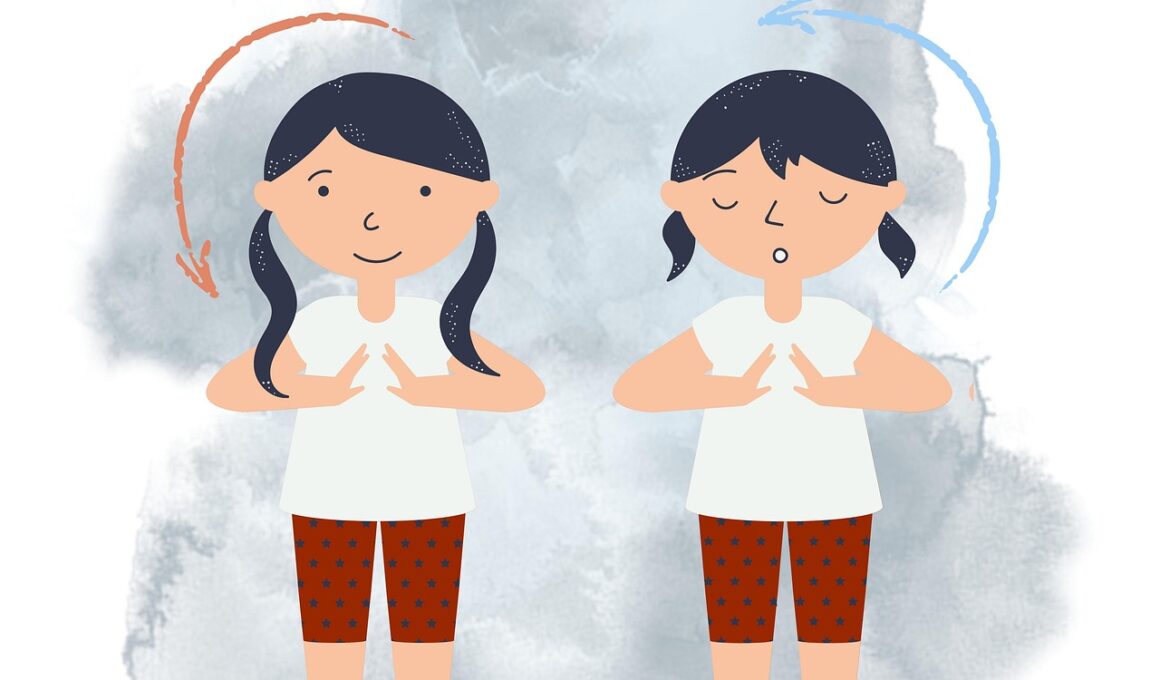The Impact of Breath Awareness on Emotional Regulation in Meditation
Breath awareness is profoundly connected to emotional regulation, particularly during meditation practices. When individuals focus on their breathing, they cultivate a heightened sense of awareness, allowing them to observe their emotions without judgment. This non-judgmental observation is crucial for understanding emotional triggers and responses. Many practitioners find that through breath awareness, they can identify feelings as they arise and manage them more effectively. Incorporating breathing techniques into meditation can also improve focus, as it draws attention away from distractions. By concentrating on the process of inhalation and exhalation, the mind has a tool to return to when thoughts wander. Moreover, breath regulation can enhance one’s ability to remain present, increasing overall mindfulness. These practices enable individuals to embrace their feelings without becoming overwhelmed, ultimately fostering emotional resilience. Research shows a direct link between controlled breathing and the modulation of the autonomic nervous system. Such findings suggest that breath awareness not only impacts emotional states but also promotes physiological well-being. Thus, integrating breath work into meditation might offer profound benefits for those seeking emotional balance.
To understand the process better, it is helpful to analyze the role of different breathing techniques within meditation. Various schools of thought suggest diverse methods to regulate breath, such as diaphragmatic breathing, box breathing, or the 4-7-8 technique. Each method serves distinct purposes and can evoke different emotional responses. For instance, diaphragmatic breathing promotes relaxation and can reduce anxiety, making it ideal for individuals facing overwhelming feelings. Meanwhile, box breathing is often utilized to enhance focus and concentration. This technique involves inhaling through the nose for four counts, holding the breath for another four counts, exhaling for four counts, and then pausing. Another powerful method is the 4-7-8 technique, which combines extended exhalation with breath holds to foster tranquility. Implementation of these techniques can significantly impact an individual’s emotional state. Regular practice can lead to a heightened state of emotional awareness, increasing the ability to respond rather than react. Experimenting with differing techniques provides valuable insight into personal emotional responses, potentially maximizing the benefits of meditation. In conclusion, identifying a suitable breathing technique is key to emotional regulation.
Understanding Emotional Regulation
Emotional regulation is the ability to monitor, evaluate, and modify emotional reactions, a skill imperative for overall well-being. Meditation paired with breath awareness offers a unique opportunity to enhance emotional regulation skills. It encourages individuals to recognize their emotions and develop healthier coping mechanisms. This process can involve simply noticing one’s breath and reflecting on how emotions manifest within the body. Mindful breathing allows individuals to experience their emotional waves without becoming engulfed. Additionally, this self-awareness aids in identifying which situations trigger specific emotions, leading to more informed choices. It develops a perspective that facilitates the ability to respond positively rather than react instinctively. As breath control becomes second nature, one may notice improvements in resilience to stressors. The connection between breathing and emotional states is well-documented, with research revealing that conscious breathing can decrease cortisol levels, thereby alleviating stress. Furthermore, incorporating positive affirmations during breath-focused meditation deepens emotional engagement. Practicing self-compassion is essential, as nurturing oneself through gentle breath and kind thoughts can enhance emotional healing. This profound connection underscores the importance of breath while practicing meditation.
Integrating breath awareness into one’s daily routine can significantly enhance emotional regulation outside the meditation context. People can utilize breath techniques during stressful situations or emotional crises. Establishing a practice of taking a few moments to engage in conscious breathing allows for a mental reset. This creates room for reassessing emotional responses and engaging in healthier reactions, rather than immediate impulses. Additionally, simple strategies can be employed anywhere: deep abdominal breathing, counting breath cycles, or using breath-focused mantras. These practices help ground individuals, ensuring they remain centered amid chaos. The steady rhythm of breath establishes a sense of calm, which is critical for navigating everyday challenges. Furthermore, mindfulness of the breath acts as a powerful anchor, promoting clarity of thought. This clarity enables individuals to approach conflicts or emotional distress with a cooler head and a more balanced perspective. Gradually, this integration transforms how one perceives and reacts to everyday challenges. Emotional regulation becomes less of a struggle and more of an automatic response to life’s unpredictability. Practicing breath awareness on a regular basis reinforces the body’s natural capacity for emotional resilience and maintains well-being.
Scientific Research Supporting Breath Techniques
Research supports the efficacy of breath techniques in emotional regulation, establishing a strong foundation for integrating these practices into meditation. Studies indicate that controlled breathing can evoke physiological changes, notably decreasing heart rates and regulating blood pressure. The effects of diaphragmatic breathing on the autonomic nervous system demonstrate significant implications for stress management. Engaging in breath-focused meditation reduces anxiety and enhances emotional awareness among participants. Furthermore, research linking breath awareness with improved focus during meditation highlights its potential benefits. It promotes sustained attention, which is vital for cultivating mindfulness. Additionally, longitudinal studies demonstrate that those who practice breath techniques consistently report higher levels of emotional regulation. Participants exhibit improvements in their ability to navigate stressful life events, showcasing the transformative power of breath. These findings encourage a broader exploration of breath techniques in psychological and therapeutic contexts. Breath work can serve as an accessible tool for those seeking to enhance emotional well-being. As awareness of these benefits spreads, professionals in fields ranging from psychotherapy to wellness can incorporate breath techniques into their protocols. Ultimately, expanding access to this knowledge fosters a collective movement toward emotional health through breath awareness.
As practitioners deepen their understanding of the connection between breath and emotions, they frequently discover unique personal insights. Such discoveries foster greater self-awareness and empathic responses to others. By sharing experiences with meditation and breath techniques, individuals contribute to a community that values emotional well-being. This community often exchanges tips, resources, and practices that can enhance one’s journey. Leaning on the support of others who understand the challenges of emotional regulation contributes significantly to personal growth. Additionally, engaging with others can inspire accountability, encouraging consistency in breath practices. People often find that participating in group meditations or attending workshops provides motivation to maintain their routines. These communal experiences create a sense of belonging and shared purpose, essential in mitigating feelings of isolation. As individuals grow in their practice, they also foster connections with their inner selves, leading to a more profound understanding of their emotional landscapes. This internal connection not only benefits personal well-being but also strengthens bonds within one’s social circles. Ultimately, the journey of breath awareness in meditation reflects a profound interplay between personal growth and community engagement. Each breath becomes an opportunity for connection and transformation.
Conclusion: The Lifelong Journey of Breath Awareness
In conclusion, the impact of breath awareness on emotional regulation in meditation is profound and multifaceted. As individuals explore different breathing techniques, they begin cultivating essential skills for emotional management and resilience. This process is not a destination but an ongoing journey requiring patience and commitment. Continuous engagement with breath awareness allows one to navigate emotions with a greater sense of control and understanding. Furthermore, adapting breath techniques into daily routines fosters lasting emotional benefits, as individuals reinforce their capacity for self-regulation. The breath serves as a compassionate guide, offering solace in moments of distress. Additionally, embracing the communal aspects of breath-focused meditation expands opportunities for learning and connection. Sharing experiences within a diverse community ensures that practitioners feel supported in their journeys. The lifelong journey of breath awareness becomes more enriching and fulfilling through these shared experiences. Ultimately, the integration of breath techniques into meditation practices will lead to increased emotional awareness and resilience. The efficacy of such practices confirms the necessity of cultivating breath awareness as an essential part of mental health. Through continued practice, individuals can unlock transformative emotional growth that enhances quality of life.


